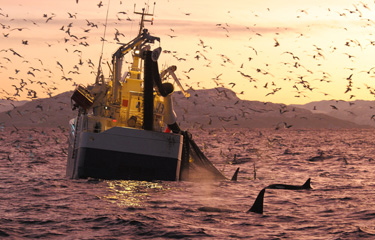Seafood industry forming methods to influence RFMO decisions

Regional fisheries management organizations (RFMOs) play an important, though sometimes opaque, role in fisheries management and governance. These international organizations control fishing quotas and adopt and manage protective measures in geographical areas of the ocean or for specific species.
This article is the last in a four-part series covering the role regional fisheries management organizations in the global seafood trade. The series is intended to help seafood companies better understand the role and impact of RFMOs and the opportunities to engage with those bodies. The first article introduced the organizations as a whole, the second focused on tuna RFMOs in the Pacific Ocean, and the third looked into RFMO management of tuna stocks in the Indian and Atlantic oceans.
There are 12 RFMOs besides the five tuna RFMOs, covering the majority of the world’s oceans and other highly migratory species. They are:
- AIDCP: Agreement on the International Dolphin Conservation Programme
- NEAFC: North-East Atlantic Fisheries Commission
- NAFO: Northwest Atlantic Fisheries Organization
- NASCO: North Atlantic Salmon Conservation Organisation
- SEAFO: South-East Atlantic Fisheries Organisation
- SIOFA: Southern Indian Ocean Fisheries Agreement
- SPRFMO: South Pacific Regional Fisheries Management Organization
- CCAMLR: Convention on Conservation of Antarctic Marine Living Resources
- GFCM: General Fisheries Commission for the Mediterranean
- CCBSP: Convention on the Conservation and Management of Pollock Resources in the Central Bering Sea
- WECAFC: Western Central Atlantic Fisheries Commission
- CECAF: Fisheries Committee for the Eastern Central Atlantic
Tom Pickerell, the executive director of the Global Tuna Alliance, said seafood supply chain companies have little engagement with these lesser-known RFMOs, despite the important role they play in fisheries management. But he said that is starting to change.
“Companies are very unaware, I think most people have probably heard of them [RFMOs] or could probably name a couple of RFMOs, but actually knowing what they do and the measurements they put in place is beyond them,” Pickerell said.
The North East Atlantic Fisheries Commission (NEAFC) is a collective of 53 retailers and supply chain businesses that have called for better management of global fisheries. It recently created a “policy FIP” to cover the Northeast Atlantic mackerel and Atlanto-Scandian herring, two fisheries that lost Marine Stewardship Council certification in 2020. These species are unique as they are well-understood, data-rich, and have published management strategies, but have been punished by a lack of coherent management between coastal state actors that typically work together on unilateral quota-setting. The “policy FIP” is calling for coastal states to put aside political barriers and agree on the established science as a basis for setting quotas moving forward.
“It’s a similar issue with tuna management – countries are not agreeing on the management measures. These are countries like Norway, the E.U., U.K., Iceland, Greenland, Faroes, and Russia. These countries understand the management and the need for it and they’re still not agreeing,” Pickerell said. “So how do we expect to do it when you’ve got 30 countries from the global south and the global north, who are very much competing and whose economies and national food security actually depend on the tuna as well?”
By involving the larger seafood industry in the RFMO delegations of companies, the gap can be bridged between the industry and non-governmental organizations, presenting a major opportunity for the market to have their own voice heard to support their businesses, Pickerell said.
“I definitely think what would be important is how the market can influence [delegates to RFMOs]. Or, how the market should be influencing them, because these organizations manage the fisheries, but they very rarely hear from the market. They hear from NGOs and they hear from catchers and of those two, the catchers are listened to and the NGOs barely,” he said. “But the markets and NGOs are often on the same page, so they could very much easily be saying similar things, if not the same thing, and change the dynamic to actually use commercial power to influence what’s happening.”
The Global Tuna Alliance provides an example for others can in terms of engaging in partnerships between the seafood industry and NGOs in pushing the world’s RFMOs to improve their management practices, Pickerell said.
“This is exactly what [we’re] doing in the Northeast Atlantic. We’ve got 53 companies that have come together and two FIPs [Fishery Improvement Projects] – one for mackerel and herring and one for blue whiting in the MarinTrust [certification program] – using that pattern to shift the dynamic away from short termism to the market. So far, 33 of the companies [involved in the fishery] have put statements out that say, ‘This is what’s going to happen if things don’t change.’ We could be doing that for other RFMOs that are performing poorly.”
GTA’s aim is to harness its members’ commercial buying-power to influence change through direct engagement with the RFMOs and through supply chain changes.
“That means all the individual partners do things within their supply chains to require change. For example, they can advocate for 100 percent observer coverage aboard their tuna vessels, [or] they can request that from the people they buy tuna from. Depending on the issue, the advocacy might be a 50/50 split, it might be a 100 percent advocacy … or may be 100 percent advocacy within the supply chain, such as requesting GSI-certified seafood,” Pickerell said.
RFMOs are important to all sectors of the seafood industry, as they establish conservation and management measures for over 91 percent of the oceans, according to Sam Grimley, the executive director of Sea Pact, a pre-collaborative nonprofit with 14 North American seafood companies as members. If RFMOs were able to provide improved predictions of stock health, better biological data, and improved sustainability efforts, it would advance global food security and support stronger economies, he said.
“Recently, Sea Pact went through a prioritization exercise, where the companies assessed which seafood commodities/species were important to their own businesses viability, but also which commodities or species were the most challenging in terms of securing responsibly sourced products. Interestingly but probably no surprise, fresh/frozen tuna was a top priority for all Sea Pact members, followed by squid. If you consider the global production volumes of both tuna and squid, the majority falls under – or should fall under – RFMO management, so it is necessary to engage RFMOs and support management measures to ensure these major fisheries are managed responsibly. This prioritization effort has helped Sea Pact members identify where they need to collectively support sustainability improvement efforts, which is obviously where the intersection with the RFMOs come in,” Grimley told SeafoodSource.
Formation of pre-competitive collaborations to engage RFMOs present unique opportunity for the market and other industry members to be heard on the importance of protecting the health of the oceans, he said. Sea Pact demonstrates how more companies from the seafood industry are becoming aware of the power of RFMOs and getting involved to influence their decisions, according to Grimley.
“Companies at every level in the supply chain have the opportunity to become aware of RFMO importance and engage through collaborative efforts,” he said. “Unfortunately, many companies are not aware of the role they play in these supply chains, therefore missing the chance to engage meaningfully in stock management.”
Photo courtesy of Alessandro De Maddalena/Shutterstock






Share